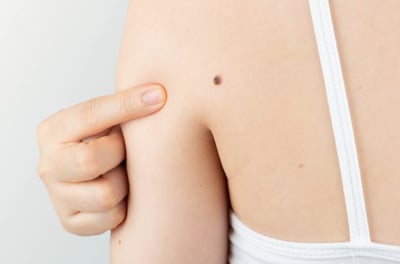
Skin cancer is the most common cancer in the United States. In fact, more skin cancers are diagnosed in the US each year than all other cancers combined. The good news is that skin cancer, when detected early, is highly treatable. The Skin Cancer Foundation recommends that everyone practice monthly head-to-toe self-examinations of their skin, so that they can find any new or changing lesions that might be cancerous or precancerous.
Conduct these monthly skin self-evaluations at home in a well-lit room, in front of a full-length mirror. You may need a family member or a close friend to assist you to scan hard to view areas, such as your scalp and your back. Dr. Rachel Ade Koziczkowski, a board-certified dermatologist with Forefront Dermatology in Moline, Illinois, suggests, “This quick 10-minute procedure could be life-saving. You can have your dermatologist give you an initial lesson on performing a complete skin examination in your office at your annual skin-cancer screening appointment to learn how to perform one at home on your own.”
For additional resources to perform an at home skin-cancer screening, download the American Academy for Dermatology’s body mole map to document your self-examination, or the How to SPOT Skin Cancer™ Infographic so you know what to look for when checking your spots.
To perform an at home skin cancer self-examination, follow the steps below recommended by the Skin Cancer Foundation. This will help you to monitor any changes in spots on your body and bring them to your dermatologist’s attention as early as possible.
- Begin by examining your face, including your nose, lips, mouth, and ears. Do not forget the backs! Use your mirror and a secondary mirror if needed.
- Inspect your scalp carefully selecting one section at a time. Use a comb or other tool to ensure that you examine each section. Have a friend or family member help you if possible.
- Scan your hands carefully beginning with your palms and the backs of your hands. Carefully examine between your fingers and under your fingernails. Continue up the wrists to examine both the front and back of your forearms.
- Standing in front of the full-length mirror, begin at the elbows and scan all sides of your upper arms. Don’t forget the underarms.
- Next, focus on the neck, chest and torso. Women should lift breasts to view the undersides.
- With your back to the full-length mirror, use the hand mirror to inspect the back of your neck, shoulders, upper back and any part of the back of your upper arms you could not view in step 4.
- Still using both mirrors, scan your lower back, buttocks and backs of both legs.
Your Local Skin Cancer Experts at Forefront Dermatology are Here to Help
If you notice a spot that is different from others, or that changes, itches or bleeds, make an appointment to see your local Forefront dermatologist — our experienced, collaborative team of board-certified dermatologists and fellowship-trained Mohs surgeons provide are the country’s top experts in skin cancer diagnosis and treatment.





